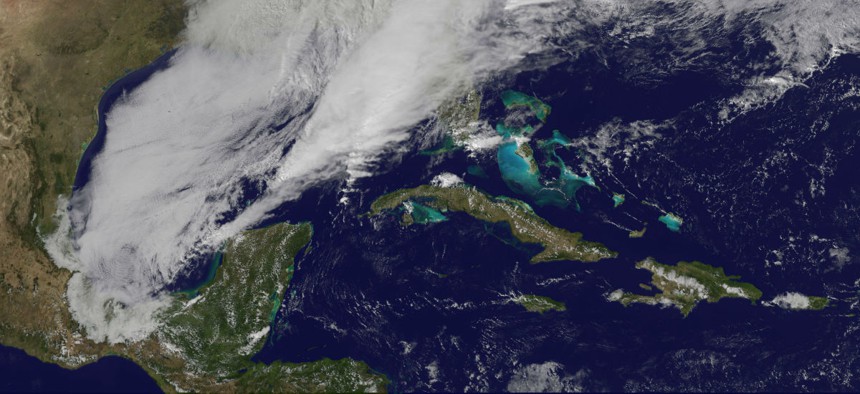
Flickr user NASA Goddard Space Flight Center
Weather Service Staff Shortages Have Led to Burnout Among Employees
Agency is working on ways to hire meteorologists faster after 2013 hiring freeze created a backlog.
Officials at the Government Accountability Office reported this week that an extensive hiring backlog at the National Weather Service has led to burnout among meteorologists at the agency, who are frequently shifting schedules and working overtime.
NWS plays a vital role in tracking weather across the country, frequently sending out warnings and advisory alerts to Americans when severe storms are imminent. But the agency, which is a part of the National Oceanic and Atmospheric Administration in the Commerce Department, has suffered from an acute hiring backlog stemming back to sequestration in 2013.
According to a GAO report released Wednesday, as the sequester took effect, NOAA implemented an agency-wide hiring freeze, during which time NWS saw some attrition in its ranks.
But when that measure was lifted in 2014, NOAA’s Workforce Management Office, which handles human capital issues, was ill-equipped to deal with the increase in hiring demand since it had seen more than half of the staff that handle hiring leave the agency during the freeze. In fiscal 2016, attrition at NWS outpaced hiring—191 employees left the agency, while the workforce management office was only able to hire 157 external candidates.
GAO said that vacancies at NWS increased from 5 percent at the end of fiscal 2010 to 11 percent by the end of fiscal 2016. And between fiscal 2014 and fiscal 2016, the number of vacant meteorologist positions increased by 57 percent, while positions within management dropped 29 percent.
NWS officials told analysts that they had seen vacant positions go unfilled anywhere from several months to “a few years.”
Officials and meteorologists worked to minimize the impact of the vacancies on NWS’ ability to alert the public to the threat of severe weather, but they were “at times unable to complete key tasks and were experiencing stress and fatigue from their efforts to cover for vacancies,” GAO wrote.
While overtime is typically used at NWS to increase the agency’s forecasting in stormy periods, officials frequently used it to cover for a lack of workers during good weather. In one regional office, officials reported consistently working 100 hours per pay period to make sure forecasts were sent out.
“When operational units have had vacancies, managers and staff have also worked overtime to cover forecasting shifts during fair weather and additional forecasting shifts during severe weather, according to NWS headquarters officials,” GAO wrote. “Several staff in one operational unit said they frequently worked 15 to 20 consecutive days without a day off to cover for multiple vacancies.”
NWS and NOAA have implemented some measures to try to reduce the hiring backlog, GAO said. Beginning in 2014, NOAA hired contractors to help process job candidates, but they too have been unable to keep up with demand. And the agency is in the midst of implementing a new shared services system for handling human capital issues across the Commerce Department, but it has been slow going due to funding limitations.
Officials also have begun combining several hiring requests for similar positions into a single job announcement and keeping a rolodex of candidates for lead meteorologist jobs to streamline the hiring process.
Entry-level meteorologist jobs are now restricted to external candidates, since internal candidates, who made up more than half of all hiring actions from fiscal 2010 to fiscal 2016, in turn create another vacancy for the agency to fill.
But GAO said the agency has not taken action to evaluate how effective these measures have been. The watchdog agency recommended that NOAA routinely provide NWS managers with information about where their requests are in the hiring process, and it said NWS officials should be required to examine whether recent actions are working to reduce the backlog.
NOAA concurred with GAO’s conclusions and recommendations, and noted that the new human capital system, when implemented, will better track the hiring process.







